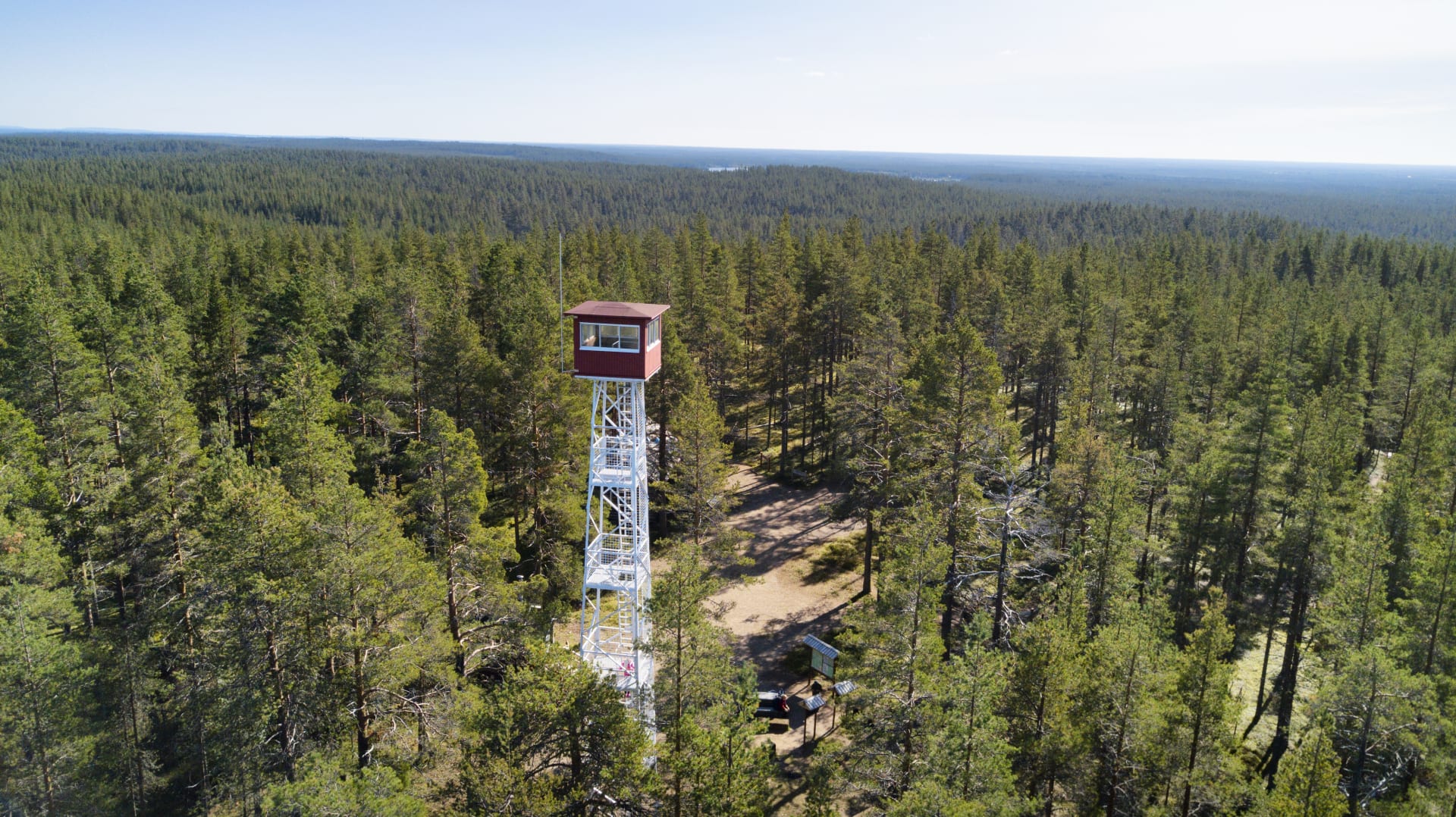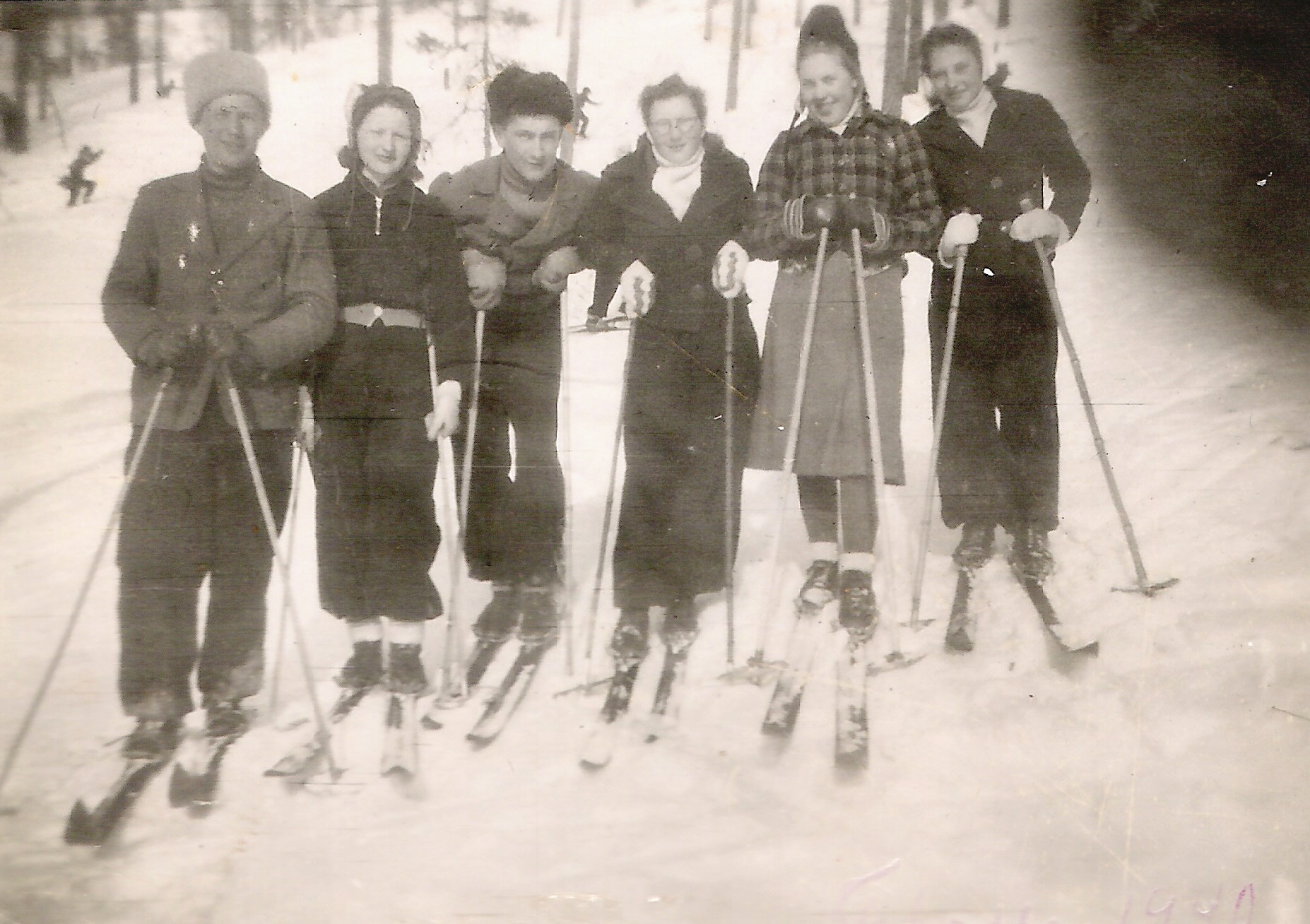The hilly terrain of Rokua became a favourite destination for people of Oulu at a time when the area was still mostly undeveloped wilderness. The altitude differences were an exception in the lowland fields of Ostrobothnia, and there were no similar areas so suited for skiing nearby. Tourism in the area began to develop around skiing from the 1930s onwards.
Rokua became more widely known as a skiing destination after the Second World War. Popular ski resorts in Lapland had been destroyed and roads to Lapland had been damaged by the war. At the same time, people were poorer and started to look for skiing destinations closer to home. Interest in skiing and a keen outdoor spirit were growing strongly in Finland at the time.
Riding the train to the skiing slopes
Winters were snowy and the skiing season was long, often lasting from November to April. For the working-class skiers of nearby Oulu, Sunday was often the only day off in the week when they could go outdoors. At its heyday, hundreds of skiers visited Rokua on Sundays.
There were no proper roads to Rokua so there was no car access, but a railway line had been opened in 1929. On Sunday mornings, the skiers arrived by train at the Ahmas station in Utajärvi and skied another eight kilometres through the forest to get to the hills of Rokuanvaara.
At the station, the train conductor stacked the wooden skis in the snow and everyone picked up their own. The conductor would then throw a backpack on his back and join the skiing line going to Rokua. Sometimes snow had fallen so heavily during the night that the first skiers had to clear the path for the others. In the evening, they went back and took the train home.
The only accommodation in Rokua at that time was the Pooki lodge, built by Utajärvi white guard in 1936. Now owned by a local sports club, it provided a place for warming up and eating your rations by a fire stove.
Pookivaara was a familiar place for the oldest of the skiers who had skied in the hills of the highest point in Rokua when they were children. They later recalled that if you dared to race down the Pooki hill, a reputation as a daredevil from your mates was guaranteed.
Skiing became so popular that the lodge became too small for the ever-increasing number of visitors, who flocked not only to the skiing paths, but also for skiing competitions and, during the summer season, to go hiking.
Rokua gains national renown
Local sports clubs Utajärven Urheilijat and Rokuan Ryhti organised skiing competitions in Rokua, which were the main events of the winter season and became attractions on par with the competitions in Ounasvaara in Rovaniemi. At their most popular, the games attracted almost 800 spectators. The skiing tracks circled around and across the hills of Rokua, and the excellent conditions attracted a number of renowned participants, including Olympic medallist Sauli Rytky and Salpausselkä winner Arvo Kippola.
In the 1940s, the development of Rokua was the subject of a lively debate in regional newspaper Kaleva, and the public exchange of views spread the reputation of the area beyond the surrounding areas. The development work got a boost when active Oulu skiers Valde Näsi, Toivo Sirén, Aarno Aranto and Heikki Klemetti founded the Rokua Society in 1946. They wanted to make the area they admired known to the entire nation.
The Rokua Society’s mission statement reflected the post-war spirit of physical exercise and sports. In the founding minutes of the society, its mission was summarised as follows: “We, the undersigned, have today decided to establish the Rokua Society, the purpose of which is to promote Rokua as a place for hiking, sports and recreation and to inspire its members and all circles of citizens to take part in hiking and sports.”
The Rokua Society sought to increase accommodation facilities and rented a plot of land from the Metsähallitus at Lake Lianjärvi, where a ski lodge was built in 1948. The ski lodge became very popular; in its heyday, more than one hundred skiers visited the lodge every day. According to the guest book, they came not only from nearby areas but also from further afield, including Helsinki and abroad.
The wooden ski jump tower of Pookivaara in the early 1950s. Photograph: Pekka Oilinki. Private collection of the Pirilä Family Association / Solja Holappa.
Ski jumping in Poor Man’s Lapland
Oulu skiers also gave Rokua its nickname Poor Man’s Lapland that became famous in the 1950s, reflecting the fact that people could get there quickly during the working week. Even though the name might have been found less agreeable by some, it was first and foremost a tribute to the magnificent landscape.
Another noteworthy event was President Urho Kekkonen’s skiing trip to Rokua in the 1960s, where he had come after longing for a landscape with both low and high hills and pleasingly sparse forest, as he had heard Tahko Pihkala praise Rokua. After his visit, the President expressed his admiration for the properties of what he considered an ideal skiing location in Oulu newspaper Kaleva. Opportunities are offered for skiers of all abilities and all predilections. — I know many skiing resorts in Finland, but Rokua is up there with the best, if not ahead.
The winter events in Rokua began to diversify in the 1950s. This gave birth to the idea of building a ski jump. The site that was chosen was a ridge on the land rented by the Rokua Society near Lake Lianjärvi. The jumpers started from the top of the ridge and landed on the frozen lake. Funds for the construction work were probably obtained from national lottery funds and, customary to the time, the work was carried out as voluntary effort. Building materials were obtained from the nearby forest, and the logs were bolted together by hand during the winter frosts. One can only imagine that working the frozen logs was not completely without a risk.
Construction of the ski jump began in 1953 and was completed the following year. The inauguration ceremony took place in the winter frosts on 30 January 1955 during a national downhill skiing competition. Despite the biting frosts the turnout was good. The ski jump was an important project as the nearest one was 200 kilometres away in Taivalkoski. The Finnish Ski Association sent its congratulations and hoped that the ski jump would give new impetus to winter sports education in the region.
The ski jump was used in regional competitions for ten years, and the record jump was said to be approximately 50 metres. The tower, built of untreated wood, eventually began to decay – but that was not all. The people of Utajärvi tell how one evening two young individuals on mopeds arrived, climbed to the top of the tower to enjoy some peace and quiet together, and decided to light a fire. It wasn’t long before the floor underneath started to burn. The couple got up and disappeared as the whole landscape began to shimmer with fire debris. However, by then there were already people living in Rokua who called for help, and the fire was put out before it spread into a wildfire. The tower was eventually demolished in 1969 to prevent accidents. Now all that remains of the ski jump are the concrete foundations buried in the slope by Lake Lianjärvi.
Winter sports centre with stadium and spa
The development of tourism and hiking in Rokua gained speed rapidly in the 1950s and the 1960s. The Rokua National Park was established in 1956. More accommodation services were built, and the long-term goal was to have a camping and hiking centre or sports academy in Rokua to serve the needs of the constantly growing skiing population. On this foundation and after many twists and turns, the health spa that we know today as Rokua Health & Spa was built.
Skiing was a popular sport. One of the most notable skiers to come from Rokua is Esko Lähtevänoja, who competed successfully in the 1978 World Championships in Lahti. With his spirited opening leg, Lähtevänoja earned his team the silver medal in relay race, which inspired Paavo Noponen, the most famous Finnish sports announcer of the time, to nickname him the Rocket from Rokua.
At the turn of the millennium, many improvements were made to the trails. The European Union granted a total of €2.9 million for eight projects to build signposts, rest areas, an environmental system, a visitor centre and a ski stadium in Rokua. The stadium was inaugurated with great fireworks on 29 January 1999.
Skiing star and bishop not afraid of cold
Starting the very next day, the international-level network of skiing paths in and around the stadium hosted the national cross-country skiing championships. Some of the most famous skiers of the time, including Mika Myllylä and Jari Isometsä, participated.
It was, however, close to the point where the games would not have taken place at all, at least not on the original schedule: the temperature fell so low that the frost limit of 20 degrees Celsius was forecast to be exceeded. The weather was tracked anxiously until the last moment with new weather radar built in the region. Only few brave skiers ventured out into the cold to practice. One of them was Jari Isometsä, used to similar low temperature in his home city of Tornio.
In the end the frost was not so severe as to cancel the games. The locals say that bishop Olavi Rimpiläinen was invited to the opening ceremony as the patron to inaugurate the games, and when the frost finally gave in, jokes were made that it happened thanks to higher powers.
Even though the ski stadium has since that been consigned to history, today Rokua, a UNESCO Global Geopark, has a total of approximately 25 kilometres of well-maintained winter trails around and over the hills.
Explore:

Pookivaaran näkötorni
Rokua Geopark -alueen korkeimmalla kohdalla, Rokuan kansallispuiston Pookivaaralla, voi ihailla Rokuan erämaisia maisemia näkötornista käsin. Pookivaaralla on ollut tärkeä rooli…
Sources:
Hiihto – kymmeniä kilometrejä sivakoitavaa! ("Skiing – dozens of kilometres of tracks!"). Rokua Geopark.
Korhonen, Päivikki 1946. Rokuan Seura Rokuan kehittäjänä 1946–1996 ("The Rokua Society as a developer of Rokua in 1946–1996"). Utajärvi.
Raha-automaattiyhdistys ja ”neljän kopla” mahdollistivat Rokuan kehittämisen. ("Slot machine association and Gang of Four enable the development of Rokua"). Utajärvi 150 years. Anniversary magazine, 2015. Utajärvi.
Reponen, Jussi-Pekka. 30 Jan 1999. Pakkanen uhkaa Rokuan SM-hiihtoja ("Freezing temperatures threaten Rokua's World Ski Championships"). Helsingin Sanomat.
Rokua Storyhouse. 27 Aug 2023. Kahveroinen Community Space, Utajärvi. Five participants (identities known by the project). Implemented as part of the Fascinating stories as Rokua Geopark's attraction drivers project supported by the European Union's Regional Development Fund and the state of Finland.
Rokuanvaaran maisemat ("Landscapes of Rokuanvaara"). North Ostrobothnia. Landscape areas of national importance. VAMA 2021. Ministry of the Environment 2021.
Ruuttula-Vasari, Anne 2012. Pauhoilta Paanajärvelle – Tarinoita Pohjolasta ("From Shoals to Lake Paanajärvi – Stories from the North").
Suomen hiihto 1926–1936 ("Finnish Skiing 1926–1936"). Finnish Ski Association 1937. WSOY: Porvoo.
Syvänen, Juhani 31 Jan 1999. Lähtevänojien valtakunta ("The Kingdom of Lähtevänoja"). Helsingin Sanomat.

